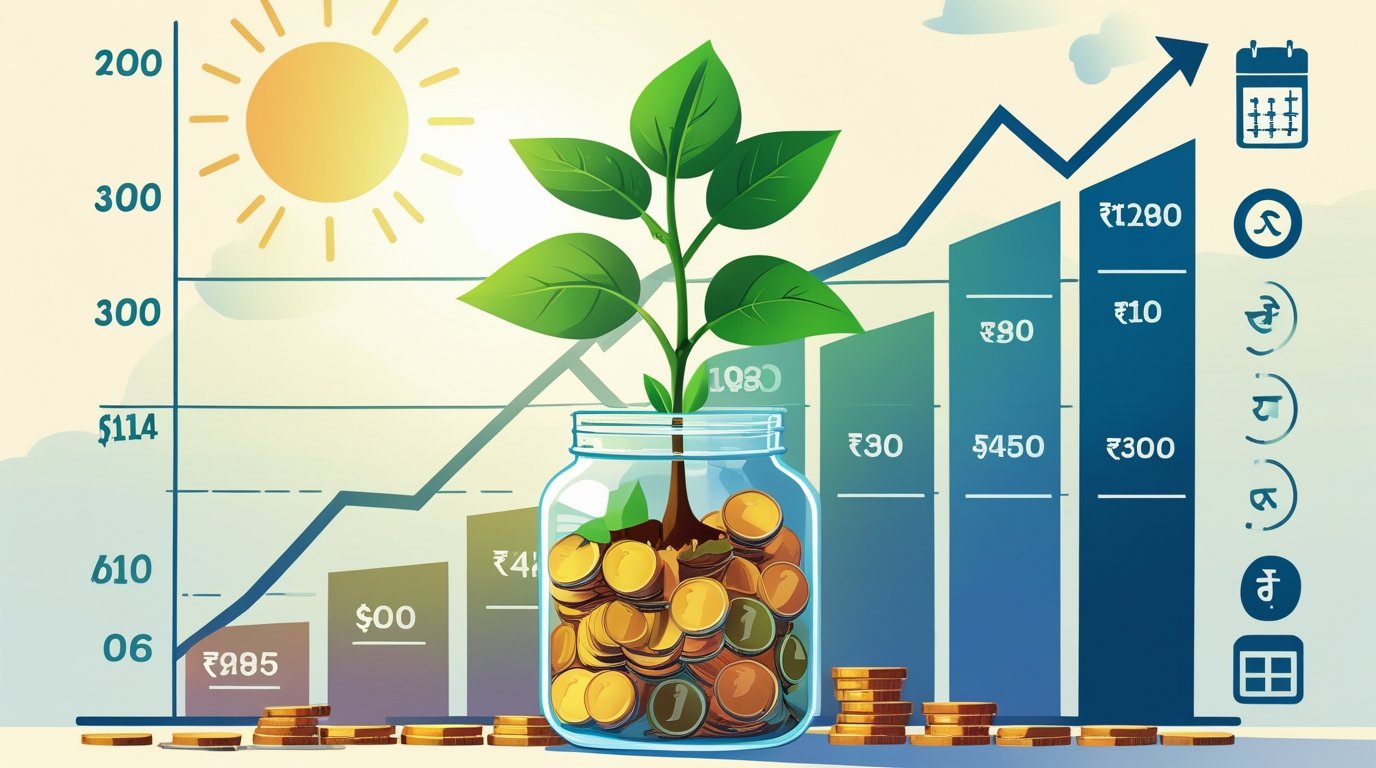Ever wondered how small, consistent savings can grow into a life-changing fortune? The secret lies in compound interest, often called the “eighth wonder of the world.” A 2024 Fidelity study revealed that 88% of millionaires attribute their wealth to early, disciplined saving. Yet, many delay saving, missing out on the exponential growth compound interest offers. In an unpredictable economy, starting early can secure your financial future. This article explores the magic of compound interest, practical steps to harness it, and 2025 trends to maximize your savings. Let’s unlock the power of starting early and watch your wealth grow!
What Is Compound Interest?
Compound interest is the process where interest earned on your savings or investments is reinvested, earning additional interest over time. Unlike simple interest, which is calculated only on the initial principal, compound interest grows exponentially, amplifying your wealth.
How It Works
The formula for compound interest is:
A = P (1 + r/n)^(nt)
- A: Future value
- P: Principal (initial investment)
- r: Annual interest rate
- n: Number of times interest is compounded per year
- t: Number of years
Example: Investing $5,000 at a 5% annual interest rate, compounded annually, grows to $8,144 in 10 years. The same amount with simple interest would yield only $7,500.
Why Start Early?
Time is the key ingredient. Starting early allows more compounding cycles, dramatically increasing returns.
- 20-Year-Old vs. 30-Year-Old: A 20-year-old investing $5,000 at 7% annually (compounded monthly) has $29,960 by age 50. A 30-year-old starting with the same amount has only $15,971.
The Benefits of Compound Interest
Harnessing compound interest offers transformative advantages.
- Exponential Growth: Small contributions grow significantly over time.
- Financial Security: Builds wealth for retirement, emergencies, or big purchases.
- Passive Wealth Creation: Earnings grow without active management.
- Inflation Hedge: Outpaces inflation (3.2% in 2024, per BLS) with high-yield accounts or investments.
Case Study: Emma’s Early Start
Emma, a 25-year-old teacher, invested $200/month in a retirement account at 6% annual return. By age 65, her $96,000 in contributions grew to $503,132, thanks to compound interest. Starting at 35 would have yielded only $243,664—a $259,468 difference.
How to Leverage Compound Interest in 2025
Follow these actionable steps to maximize compound interest.
1. Start Saving Now
Even small amounts make a difference. Begin with $50/month if that’s what you can afford.
- Micro-Investing Apps: Acorns or Stash round up purchases, investing spare change.
- Automate Savings: Set up automatic transfers to savings or investment accounts.
2. Choose High-Yield Accounts
Opt for accounts with competitive interest rates.
- High-Yield Savings: Online banks like Ally (4.5% APY in 2025) or Marcus by Goldman Sachs.
- Certificates of Deposit (CDs): Lock funds for 1–5 years for higher rates (up to 5%).
- Money Market Accounts: Offer flexibility and rates above 4%.
3. Invest in the Stock Market
Stocks historically outperform savings accounts, averaging 7–10% annual returns (S&P 500, 1928–2024).
- Index Funds/ETFs: Low-cost options like Vanguard’s VOO track market performance.
- Retirement Accounts: Contribute to a 401(k) or IRA for tax advantages and compounding.
Example: Contributing $6,000/year to an IRA at 7% from age 25 to 65 yields $1.2 million, per Vanguard’s calculator.
4. Reinvest Earnings
Reinvest dividends, interest, or capital gains to accelerate compounding.
- Dividend Reinvestment Plans (DRIPs): Automatically reinvest stock dividends.
- Bond Interest: Reinvest coupon payments into new bonds or funds.
5. Minimize Fees
High fees erode returns. Choose low-cost investments.
- Expense Ratios: Opt for funds with ratios below 0.5% (e.g., Fidelity’s Zero Fee Funds).
- Robo-Advisors: Wealthfront or Betterment charge 0.25% annually, managing portfolios efficiently.
6. Stay Consistent
Regular contributions amplify compounding. Even $100/month at 6% grows to $101,366 in 30 years.
Case Study: Mark, a 30-year-old freelancer, invested $150/month in an S&P 500 index fund. By age 60, his $54,000 in contributions grew to $225,000, showcasing the power of consistency.
Table: Compound Interest Growth Examples
| Initial Investment | Monthly Contribution | Rate | Years | Future Value |
|---|---|---|---|---|
| $5,000 | $0 | 5% | 20 | $13,266 |
| $0 | $100 | 7% | 30 | $121,997 |
| $10,000 | $200 | 6% | 25 | $171,833 |
Challenges to Overcome
- Low Starting Capital: Begin with micro-investments or side hustles to boost savings.
- Market Volatility: Diversify investments to mitigate risks.
- Inflation: Choose vehicles with returns above 3–4% to outpace inflation.
- Discipline: Automate contributions to avoid skipping.
What’s New in 2025: Savings and Investment Trends
- AI-Driven Investing: Robo-advisors like Betterment use AI to optimize portfolios, with 80% of users seeing improved returns in 2024.
- Fractional Shares: Platforms like Robinhood allow investing in stocks with as little as $1.
- Sustainable Investing: ESG funds (Environmental, Social, Governance) grew to $3 trillion in assets in 2024, per Morningstar.
- Employer Matches: More companies offer 401(k) matches up to 6% of salary, boosting compounding.
Pros and Cons of Compound Interest
| Aspect | Pros | Cons |
|---|---|---|
| Growth Potential | Exponential wealth building over time. | Requires long-term commitment. |
| Accessibility | Works with small initial investments. | Early withdrawals reduce benefits. |
| Risk Management | Diversified investments mitigate losses. | Market risks can affect returns. |
| Financial Freedom | Supports retirement or big purchases. | High fees can erode gains if not managed. |
FAQ Section
What Is Compound Interest and Why Does It Matter?
Compound interest is interest earned on both the initial principal and accumulated interest, leading to exponential growth. For example, $5,000 at 5% compounded annually grows to $13,266 in 20 years, versus $10,000 with simple interest. It matters because starting early maximizes wealth—$100/month at 7% from age 25 yields $121,997 by 55. Use high-yield savings or index funds to harness it.
How Can I Start Saving Early with Limited Income?
Begin with small amounts, like $25/month, using micro-investing apps like Acorns or Stash. Automate transfers to a high-yield savings account (4.5% APY) or low-cost index fund. Cut expenses—e.g., $50/month on subscriptions—and redirect to savings. Side hustles, like freelancing, can add $100–$300/month. Consistency and time are key to leveraging compound interest.
What Are the Best Accounts for Compound Interest?
High-yield savings accounts (Ally, Marcus, 4.5% APY), CDs (up to 5%), and index funds (7–10% historical returns) are ideal. Retirement accounts like IRAs or 401(k)s offer tax benefits. For example, $6,000/year in an IRA at 7% grows to $1.2 million by age 65. Compare options on Bankrate.com and choose low-fee accounts.
How Does Compound Interest Help in an Unpredictable Economy?
In 2025, with 3.2% inflation and market volatility, compound interest outpaces rising costs. High-yield accounts and diversified investments (e.g., S&P 500 ETFs) offer 4–10% returns, preserving purchasing power. Starting early builds a buffer for emergencies or job loss. Reinvest earnings and stay consistent to maximize resilience.
What Mistakes Should I Avoid with Compound Interest?
Avoid delaying savings—starting 10 years later halves potential returns. Don’t withdraw funds early, as it disrupts compounding. Watch for high fees (choose funds with <0.5% expense ratios). Diversify to reduce market risks. Use robo-advisors like Wealthfront for low-cost, automated management to stay on track.
Conclusion
The power of compound interest lies in its ability to transform modest savings into significant wealth, but starting early is crucial. By saving consistently, choosing high-yield accounts or investments, and minimizing fees, you can build a secure financial future. In 2025, tools like AI-driven robo-advisors and fractional shares make it easier than ever. Take the first step today—open a savings account or invest $50/month—and let time work its magic. Share your savings strategies in the comments or join our newsletter for more financial tips!
Meta Title
Power of Compound Interest: Start Saving Early
Meta Description
Unlock the power of compound interest in 2025. Learn how to start saving early, maximize growth, and secure your financial future.

